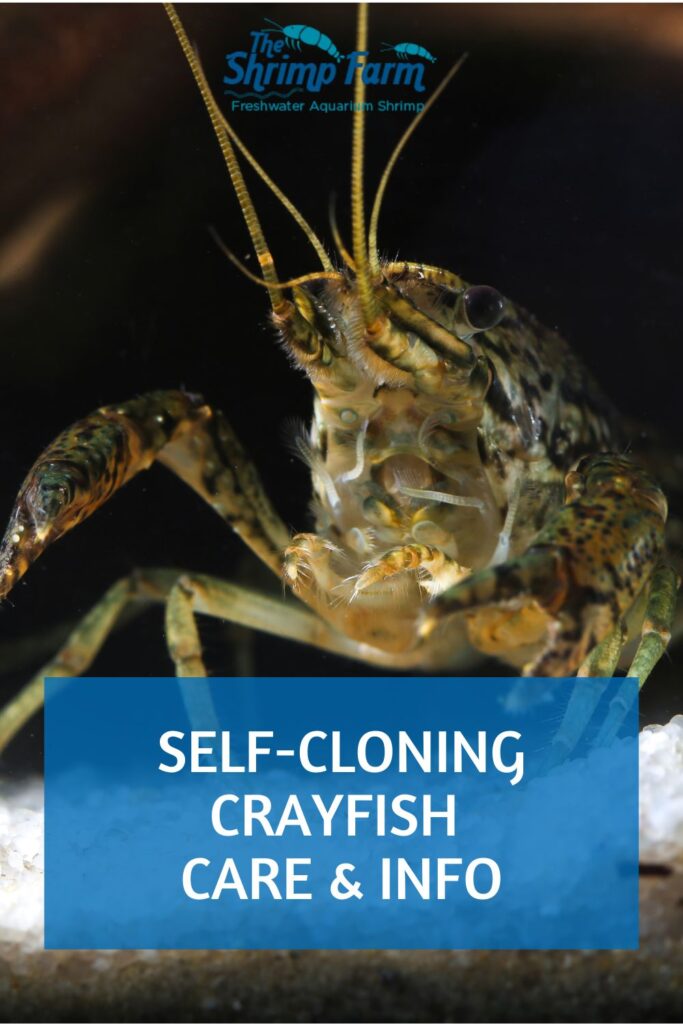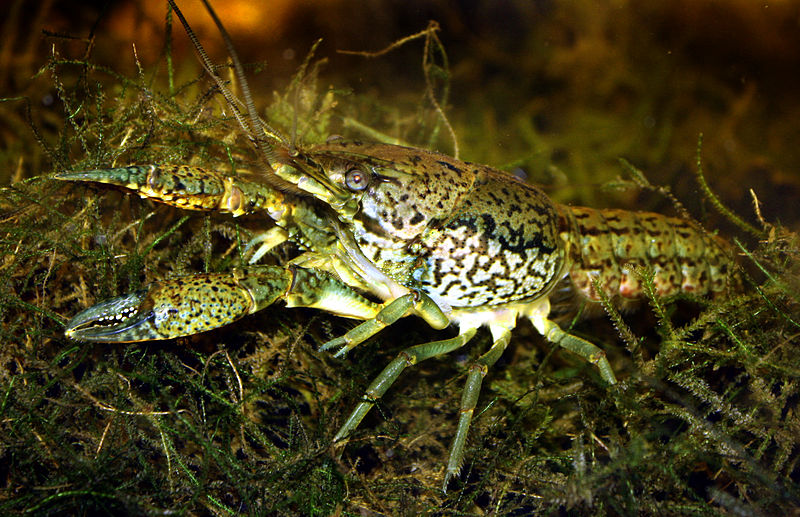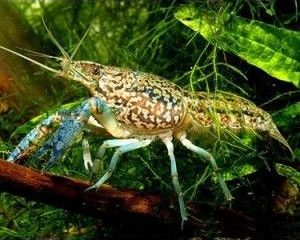Marmorkrebs | Self cloning crayfish care & info
If you're not familiar with these crayfish, you might be thinking two things right now. First, what the heck is a "marmorkrebs"? And second, did you just say "self cloning?" Yep, we're talking self cloning crayfish!
Marmorkrebs is German for "marbled crayfish", which is exactly what these crays are. And yes, they do not need a mate to reproduce! Keep reading for everything you need to know about marmorkrebs and keeping these fascinating crayfish in your own aquarium.
| Scientific name | Procambarus virginalis, formerly Procambarus fallax f. virginalis |
| Common names | Marmorkrebs, marbled crayfish, self cloning crayfish |
| Difficulty level | Moderate |
| Origin | Germany |
Table of Contents
Marmorkrebs appearance & natural habitat
Appearance
Marmorkrebs are a medium-sized crayfish that can reach a maximum length of around 5". Although their exact colors and patterns can vary, they're usually range from a sandy brown to a kind of olive tone. This is interesting given the fact that all of them are identical clones, but it goes to show how much of an influence the environment can have on an animal's appearance.
The marbled pattern, almost like sand sprinkled on the carapace, is what gave the species its name.
Natural habitat
Surprise! We don't know. Here's the deal: it's not uncommon for new crayfish species to be discovered in the aquarium hobby. Every imaginable type of freshwater creature has passed through an aquarium store at some point, including sometimes species that are still unknown to science or at least not formally described.
This is exactly what happened with the marmorkrebs, although the exceptional thing here is that even 20 years after its first description (at the time of writing), no one has been able to pinpoint where it came from. One second it wasn't there, the next it was; it likely evolved very recently.
Apparently, this marbled crayfish first popped up in the '90s in Germany. It has now been established that its closest relative is probably the slough crayfish, Procambarus fallax, which is another popular aquarium crayfish species. Since that one's from the US, it's likely that Procambarus virginalis is as well.
Invasive potential
If there's one topic you'll always see pop up when crayfish are discussed, it's their invasive potential. Because many crayfish species don't give a hoot about water quality and can survive even in contaminated waters, they're incredibly hardy. Ditch runs dry? No problem, it can just burrow.
When the self-cloning marbled crayfish was first discovered in the aquarium trade, there were immediate concerns about its potential to wreak havoc on local ecosystems. Sure, they're incredibly interesting to scientists, but only one has to get out in order for a population to be able to establish.
As the authors of the first paper on the species mentioned back in 2003, a wild marbled crayfish population would be able to spread like wildfire. It would likely outcompete native species and possibly spread a deadly (to crayfish) plague in Europe.
Lo and behold, that's unfortunately exactly what happened. These crays are everywhere in Europe now, and they're also found in a number of places in the rest of the world. They're particularly common in Madagascar, for example, although it has to be said that the locals make handy use of their rapid spread by simply eating them.
Setting up a self cloning crayfish aquarium
Marmorkrebs requirements
Marmorkrebs are closely related to Procambarus fallax, which is native to Florida and Georgia. This is not a small crayfish species. Although they aren't too fussy about water quality, I would recommend an aquarium of at least around 20 gallons (76 L) for a group.
Without a filter the aquarium will quickly become dirty, so be sure to only introduce your self cloning crayfish in a filtered and fully cycled tank. All crayfish love to hide, especially while moulting, and will appreciate plenty of cover in the aquarium. This doesn't have to be complicated. A few pieces of pvc tubing should be enough to keep your marmorkrebs happy.
You can also add rocks, fish hides and shrimp tubes to the aquarium. Anything that provides a place to hide when the crayfish are vulnerable during the molting stage should work just fine.
Plants are not much of an option, as these crayfish are omnivores with a taste for fresh greens. They are very destructive and most plants will quickly be devoured!
Note: Self cloning crayfish are escape artists that can cover great distances outside the water. Keep the water level slightly below the surface and cover any holes in the tank lid as much as possible.
Marmorkrebs water quality
As mentioned above, self cloning crayfish are not very fussy about water quality. In fact, they can survive and even reproduce in very dirty water, which is one of the reasons they're often feared as an invasive species. In the aquarium I'd still recommend keeping things as clean as possible, because a dirty aquarium is just not a pleasant sight and might quickly start smelling yucky.
Specific water values or temperatures are not needed to keep your marmorkrebs happy. Slightly hard water is preferred but not necessary and room temperature should be just fine unless your home gets very hot or cold.
pH: 6.0-8.0
Temperature: 64-80 °F/17.5-26.5 °C
Hardness: 3-15 dkh
Marmorkrebs tankmates
Tankmates can be a bit of an issue with self cloning crayfish. Unlike their dwarf cousins from the genus Cambarellus they are not always entirely peaceful and I wouldn't recommend keeping them with your shrimp unless you don't mind losing a few here and there. That being said, as far as crayfish go, marmorkrebs are definitely not the most aggressive species.
Most aquarists prefer keeping their self cloning crayfish in a single-species setup. This protects the crayfish babies from larger, hungry fish and also prevents the crays from attacking unlucky tankmates that happen to cross their path.
If you do want to combine your marmorkrebs with other species, be sure to go for quick but peaceful fish. Avoid anything slow, aggressive or bottom-dwelling.
Self cloning crayfish diet
As discussed earlier marmorkrebs are omnivores. They will eat pretty much anything you toss in their tank and might also start nibbling on aquarium plants if not enough food is provided.
Feed your self cloning crayfish a varied diet to keep them happy and healthy. Algae pellets, tropical fish flakes, blanched veggies, (thawed) frozen foods - anything you can think of probably works!
Breeding self cloning crayfish
Breeding marmorkrebs is not a difficult task at all. If you're a beginner and would like to get into breeding crays, this might be a good species to start with. Some aquarists might also like to breed self cloning crayfish as live food for other aquarium inhabitants. They make an especially great food for pufferfish, which naturally feed on crustaceans.
Honestly, there is not much you need to do to get your marmorkrebs to multiply. You only need one adult crayfish, although more obviously makes for a faster process. Supply plenty of hiding places (the more, the better). Keep the water quality high and feed a varied diet to make sure the crays stay healthy. They should start becoming berried soon.
Although most crayfish are known to eat their young, breeders generally report no such thing happening with this species. If you want to be absolutely sure, you can separate mother and fry after the eggs hatch.
The young don't need separate care and should happily feed on anything they find.
Buying self cloning crayfish
Since their discovery in the 1990's, marmorkrebs have become increasingly popular in the aquarium hobby. Although not all pet and aquarium stores carry them, it shouldn't be too difficult to find one. They self-clone, after all! Do make sure to check local regulations first, as these crays are now illegal in some places due to their invasive tendencies.
The Shrimp Farm also sells self cloning crayfish (with live arrival guarantee!), which you can find here.
Frequently asked questions
According to research, marmorkrebs can reproduce up to seven times in their lives. They first begin to clone themselves when they're around six months old and can continue doing so year-round. They can produce up to four clutches a year.



 Shrimp
Shrimp Fish
Fish Crab &
Crab & Plants
Plants Foods
Foods Snails
Snails



Good luck, I hope she takes it easy and doesn't flood you with crayfish! They really are cool little creatures.
Do you have legal crayfish in Florida? I need small crayfish for my Puffers. Currently, I am am feeding the Puffer Red & Black Ramshorn Snails. Also, Rosey Feeders. My Puffer will not eat the Rosey, unless it is pink. I bought a self cloning crayfish because Puffers like to eat them. Puffer refuses to eat frozen red worms. She Loved them as a baby. Now she will not eat red or black worms, or clam on the half shell or frozen raw fish. Very picky. What do you suggest? She Loves chasing her prey. I made a Rain Forrest for her and she Loves to Sneak around the plant leaves. Puffer thinks I do not see her.
So: as far as we have understood (though if anyone has different info, feel free to chime in), three species of crayfish are illegal in Florida. According to this doc, they are the Australian red claw (Cherax quadricarinatus), red swamp crayfish (Procambarus clarkii) and white river crayfish (Procambarus zonangulas). What that means is that self-cloning marmorkrebs actually appear to be legal. In some other states, they are not. We don't carry them right now, but since you already have one, you should be fine.
For a good alternative, we've always had great success with getting CPO crayfish to breed. I don't see anything indicating they are illegal in Florida. I bet you could have a thriving population within a few months. We do carry these, you can buy them here. You can read all about caring for them in the CPO crayfish care guide.
If you need any more info, feel free to let me know.
planning on setting the cray up in a 55g and hoping the clone so can be feeders. will not be "keeping" them with said turtles.